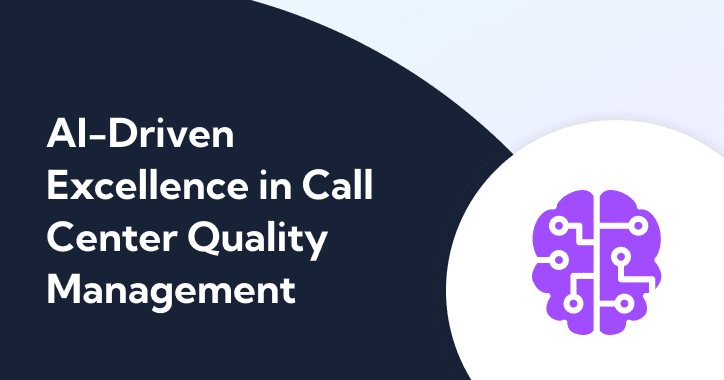In the contact center industry, we talk a lot about the importance of first call resolution (FCR). The more queries we can resolve on the first contact, the more satisfied customers are. On the flip side, we also need to keep an eye on escalations and manager requests. When customers ask to speak to a manager, they’re usually not happy.
So, as we continue our KPI series over the coming weeks, in this article we’re going to focus on manager requests and how to reduce them.
What Are Manager Requests and How Are They Measured?
A manager request or escalation occurs when a customers ask to speak to a supervisor or an agent doesn’t believe they can resolve the issue on their own. You can measure the rate by dividing the number of escalations by the total number of customer interactions.
Escalation Rate Formula
Number of Escalation Requests / Total Number of Customer Interactions = Escalation Rate
Industry benchmarks put the call escalation rate at about 10%.
Why Are Manager Requests Metrics Important to Contact Centers?
When you see your manager requests rise, especially if they go above that benchmark, it’s a sign something’s not right.
Call escalation can occur because an agent:
- Lacks training
- Lacks confidence
- Handles a contact poorly
- Fails to recognize warning signs
- Doesn’t have access to the needed resources
While sometimes escalation occurs because a query is complex or unique, it’s estimated that as many as eight in 10 escalations could have been handled at the initial point of contact.
Reducing your manager requests is important for several reasons. When managers have to interact with customers due to an escalation, it pulls them away from agent coaching, training, and other duties that can help reduce other escalations.
When customers feel it’s necessary to talk to a manager or supervisor, it generally impacts other important call center metrics as well. CSAT scores can take a hit. Call center average handle time (AHT), on-hold time (OHT), and first contact resolution are also impacted.
So, taking proactive steps to reduce escalation and manager requests is important to improve overall efficiency.
How Can You Reduce Manager Requests and Escalations?
Here are seven tips to help you reduce contact center escalations.
Better Training
While you want to keep your ramp rate for agents low and get new employees working as quickly as possible, you also need to make sure you’re training agents properly.
Not only do you need to train contact center agents on procedures and processes, but you need to provide them with the information they need to handle customer queries. Most escalation can be resolved if agents have the right tools.
Training also requires coaching on handling escalations. This includes:
- Active listening and allowing customers to talk uninterrupted
- Expressing empathy and genuine concern for customer problems
- Remaining calm even when customers are not
- De-escalation strategies for angry customers
- Using positive vocabulary
- Focusing on solutions and keeping customers informed throughout the process
Maintain a Deep Knowledge Base and Playbooks
For agents to do their job, they need access to a deep knowledge base that contains the information they need about products, services, and processes. Continuous updates should be made as new information is added.
Well-constructed knowledge bases make it easy for agents to find the information they need and reduce their need to be experts in every situation. When the information is readily available and easily accessible, it reduces escalations.
In evaluating your knowledge base and playbooks, you should talk to your agents. A survey by Balto showed that 64% of agents thought there needed to be changes to scripts. However, most agents are never asked. When agents are involved in upgrading playbooks, they are more likely to be engaged and stick to them.
Employ Guided Contact Center Software
One of the best ways to reduce escalations is to use a guided contact center software solution. When you can analyze contacts in real-time and direct the call flow, it helps improve performance and also helps with training.
The software can listen to calls in real-time and provide dynamic prompts that help agents know the right things to say to achieve positive outcomes. The best software solutions will provide a checklist to remind agents what they need to accomplish and check off items automatically as they occur.
This goes beyond basic decision trees. Artificial intelligence can listen to caller interactions and guide agents on different pathways if needed.
Deploy an Escalation Matrix
Contact center managers should have a formal escalation matrix in place to help agents when they encounter situations. They should know when it’s appropriate to escalate a matter and where contact should be referred.
Customers get extremely frustrated when they’re shuffled from one person to the next, even if it is a manager. Agents should always know when it’s the right time and who is the best person to handle any escalation.
Use Real-Time Coaching
One of the best times to coach agents is when conversations are occurring. With the right software, supervisors can utilize a call quality monitoring solution and provide real-time coaching to help provide feedback, answers questions, or de-escalate situations without having to put customers on hold or take over calls.
The best contact center software will listen for key indicators and alert supervisors that should listen in on calls to provide real-time coaching. Sentiment monitoring can help determine when customers are unhappy or frustrated as well.
Score Every Call
For years, contact centers have spot-checked calls, recordings, or transcripts to assess agent performance. They may also randomly listen to calls to see how agents are handling callers on the spot. Today, you can score 100% of contacts automatically with the right contact center software. This can help you spot trouble spots, identify agents that need additional coaching, and reduce escalations.
Continually Optimize Systems and Processing
Managers should always be analyzing call escalations and looking for inefficiencies or roadblocks that led to a manager request. Over time, patterns start to emerge that can identify gaps in information, training, or processes that can be improved.
Reduce Contact Center Escalations
When you reduce manager requests and escalations, you’re serving your customer better and improving your efficiency.
If you would like to learn more about how Balto can help you improve your escalation rate and help your contact center run more efficiently, schedule a demo and see Balto in action.
Coach Critical Moments in the Moment
Drive immediate agent improvement by coaching the right calls in real-time. Scale perfect conversations with Real-Time Coaching.






